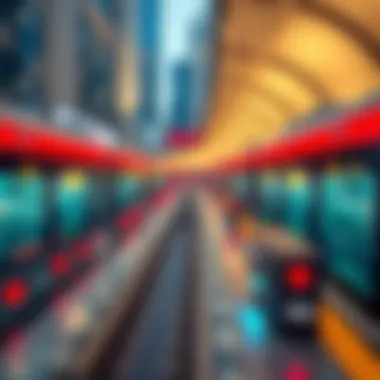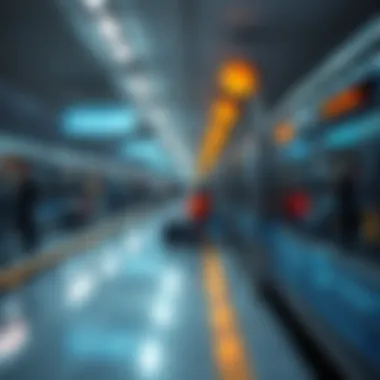Metro Timings in Dubai: A Complete Guide


Intro
Navigating a bustling city like Dubai can feel like a maze for many, especially if you’re unfamiliar with its public transportation system. Among the various modes of transit available, the Dubai Metro stands out as a reliable lifeline for residents and tourists alike. Using the metro not only simplifies your journey but also offers a unique opportunity to experience the city from a different perspective.
To grasp the full scope of what the Dubai Metro brings to the table, it’s essential to delve into its operational timings. Understanding these timings is crucial for more than just knowing when to catch the next train; it can significantly affect your travel experience, whether you’re commuting to work, exploring a new area, or connecting to other forms of transport.
In the sections that follow, we will examine detailed schedules for both weekdays and weekends, as well as special occasions, all while shedding light on commuting patterns and how the metro integrates with the larger transport network. A comprehensive grasp of these timings can aid in planning your trips more efficiently, ultimately saving you time and enhancing your experience in this vibrant metropolis.
Preface to the Dubai Metro System
Navigating a bustling city like Dubai can feel a bit overwhelming, especially for those unfamiliar with its layout and transport options. The Dubai Metro, which began operations in 2009, has become a crucial pillar of the city’s public transportation system. It not only connects key residential areas with commercial zones but also offers an efficient means for tourists exploring the city. When understanding metro timings, one must appreciate how these schedules cater to the diverse needs of residents, commuters, and visitors alike.
Overview of the Dubai Metro
The Dubai Metro comprises two main lines: the Red Line and the Green Line. Each line offers an extensive reach across the city, stretching from the bustling heights of Downtown Dubai to the serene shores of Jumeirah. With 47 stations strategically placed, it minimizes travel time while maximizing convenience. The trains are modern and well-maintained, ensuring a smooth ride through the city’s contrasting landscapes, from towering skyscrapers to charming neighborhoods.
One of the standout features of the Dubai Metro is its integration with other forms of public transport, such as buses and trams. This synergy enables seamless transfers, making it easier for passengers to reach their destinations without unnecessary delays.
Moreover, the metro system is known for its punctuality. With trains arriving at regular intervals, passengers can plan their commutes with confidence. For those pressed for time, the metro presents a stark contrast to road travel in Dubai, where traffic congestion can often lead to long delays.
Significance of Public Transport
Public transport is a game changer in urban settings, and Dubai is no exception. The Metro democratizes access to the city, allowing individuals from different walks of life to traverse its expanse without relying on personal vehicles. This is particularly beneficial in a city where the cost of owning a car can be exorbitant.
Key advantages of using the Dubai Metro include:
- Cost-effectiveness: Fares are designed to be affordable, promoting usage among a broad demographic.
- Eco-friendliness: By reducing reliance on cars, the metro contributes to lower carbon emissions, amplifying Dubai’s sustainability efforts.
- Convenience: With stations located near major attractions, the metro provides easy access for tourists, thereby enhancing their experience.
Furthermore, efficient public transport like the Dubai Metro alleviates the strain on road networks, improving overall traffic conditions. As such, understanding its timings isn’t merely about knowing when trains come and go; it’s about grasping the larger narrative of urban life in Dubai and its commitment to providing a superior quality of life through improved accessibility and connectivity.
"The Dubai Metro is not just a means of transport; it is a reflection of the city's aspiration to be a global hub of efficiency and sustainability."
Metro Operating Timings
The operating timings of the Dubai Metro are a crucial aspect of urban mobility that cannot be overlooked. Understanding how the metro operates throughout the week gives riders a significant advantage, enabling them to navigate the city with ease and efficiency. From early morning commuters headed to work, to night owls returning from a late shift, the metro's schedule adapts to the needs of its diverse user base. By examining the timings in depth, residents and visitors can optimize their travel plans, making the most out of this vital transportation service.
Weekday Operations
The weekday operations of the Dubai Metro are designed to accommodate the bustling pace of life in the city. Unlike other modes of transportation, which may be hampered by traffic or parking issues, the metro provides a steady and reliable alternative.
Morning Peak Hours
Morning peak hours typically span from 6:30 AM to 9:00 AM. This is when the metro sees the highest volume of passengers, as workers flock to their offices. The key characteristic of this period is the increased frequency of trains, which run every few minutes to manage the surge in commuters.
The benefit of utilizing the metro during these hours lies in its efficiency. It allows individuals to bypass the daunting traffic jams that plague Dubai’s roads. One unique feature is that the metro's trains are specifically designed to accommodate large groups, with standing room available, ensuring that more passengers can board in each cycle. However, this can also pose disadvantages, as trains tend to be crowded, and finding personal space may become a challenge.
Midday Operations
The midday operations, occurring from approximately 9:00 AM to 2:00 PM, experience a noticeable decline in commuter traffic. During this time, the metro runs on a slightly less frequent schedule but still maintains an orderly flow for those traveling short distances.
Your key benefit here is that the trains are less crowded, providing a much more comfortable experience. The unique aspect of midday operations is the convenience they offer to shoppers and tourists, allowing for easy access to malls and attractions without the pressures of rush hour. Nevertheless, this period may not serve business commuters as effectively, due to reduced train frequency and potential longer wait times.


Evening Services
Evening services generally kick off from 2:00 PM until midnight. Much like the morning, this time frame sees a strong influx of passengers as people finish their workday and head home or to social engagements. The trains run with frequency, helping to accommodate the crowd.
A notable characteristic of evening services is the extended operational hours on certain days, catering to late visitors or those coming back from events. How beneficial this is! The disadvantage, however, could be the mixed flow of commuters heading both home and for leisure, creating a hustle-bustle atmosphere during the late hours.
Weekend Operations
Weekend operations bring a shift in dynamics, as the schedules are tailored to meet the different needs of metropolitan leisure trips.
Friday Timing Adjustments
On Fridays, the timings of the metro are adjusted significantly to accommodate the local culture and specific prayer times. Generally, the services start later, around 1:00 PM. The key aspect here is that it provides a unique way for the community to align their transportation needs with social customs.
This adjustment is beneficial as it encourages families to utilize the metro for outings after prayers, making it a popular choice among residents. However, fewer early trains might pose a challenge for business activities that begin on Fridays.
Saturday and Sunday Schedules
On Saturdays and Sundays, the metro resumes a more typical schedule, starting from 10:00 AM on Saturdays, while Sunday mirrors the weekday schedule. This characteristic is essential for weekend planners, as many residents and tourists schedule outings during these days.
The advantage here is the flexibility it provides – families and individuals can freely travel to city attractions, enjoying a stress-free journey. A downside, though, might be can the rush of passengers returning from weekend activities seen during peak hours.
Public Holidays and Special Events
Public holidays and special events often lead to unique alterations in metro services.
Holiday Schedules
During national holidays, the metro operates on a special schedule that caters to increased demand. These schedules often reflect extended hours, accommodating the festive crowd enjoying celebratory activities. This adjustment is beneficial for families wanting to partake in community events without the hassle of ground traffic. The unique feature is that holiday schedules typically include additional trains that run more frequently, creating ample opportunities for exploration and engagement with city events. However, this may result in overcrowding, leading to some passengers having to wait longer for a ride.
Event-Based Timing Changes
Special events, such as concerts and exhibitions, prompt the metro to adapt its operational hours. The key characteristic of these adjustments is their proactive nature—the metro system often announces extended hours and special routes ahead of time to anticipate large crowds.
Such timelines are favorable for event-goers, ensuring they have a reliable mode of transport available. Potentially, though, these adjustments can lead to confusion among habitual users if they are not effectively communicated in advance.
The Dubai Metro adapts seamlessly to the changing tides of urban life, ensuring that it remains a relevant and powerful choice in the transportation mix of the city.
Factors Influencing Metro Timings
Understanding the factors that influence the timings of the Dubai Metro is crucial for anyone who relies on this system for their daily commute or occasional travels. The timing schedules are not set in stone; they are fluid and adapt to various conditions that affect passenger flow and service delivery. Recognizing these factors helps riders plan their journeys more efficiently and ensures a smoother travel experience.
Passenger Volume and Demand
One of the most significant elements affecting metro timings is the passenger volume. The Metro system is designed to cater to thousands of commuters each day, and the flow of passengers varies greatly during peak and off-peak hours.
For instance, during the morning rush, typically between 7 AM and 9 AM, hundreds of workers from neighboring emirates flock to Dubai for their jobs. The Dubai Metro addresses this surge through increased train frequencies and extended service times. On the flip side, the demand tapers off dramatically during mid-morning and early afternoon, leading to longer intervals between trains.
Conversely, evenings see another spike with commuters heading home or venturing out for social activities. It’s a typical scenario: You find yourself waiting longer during off-hours, while peak times invite crowded trains. Passengers should consider checking real-time updates on the Dubai Metro app or website to avoid unpredictability, especially if they plan to travel during busy times.
Maintenance Work and Service Interruptions
Regular maintenance and unexpected service interruptions can also greatly influence metro timings. The Dubai Metro is known for its efficiency, but like any other complex transportation system, it cannot avoid planned or unplanned outages.


Planned maintenance usually occurs during off-peak hours, often late at night or early in the morning, which might affect service availability. Authorities inform commuters ahead of time through various channels, including social media and announcements at stations. However, unplanned interruptions, such as technical faults or external factors like weather issues, can cause considerable delays.
Commuters are recommended to stay connected through various platforms, like the official RTA app or the RTA website, to stay informed of any sudden changes. Familiarity with common patterns of delays, especially influenced by maintenance schedules, helps in making alternate travel plans when needed.
"Understanding the variables affecting metro timings not only saves time but also enhances your commuting experience in Dubai."
In summary, the interplay between passenger demand and maintenance needs plays a critical role in shaping the metro timings. Commuters equipped with this understanding can navigate the system like a pro, ensuring they get from point A to B without a hitch.
Understanding Ticketing and Fare Structures
When navigating through a bustling city like Dubai, understanding the ticketing and fare structures of the metro is essential for smooth travel. This topic plays a crucial role in ensuring commuters are aware of their options, helping them save money while optimizing their time. From standard fares to various discounts and concessions, grasping these details enhances the overall travel experience.
Standard Fares
Standard fares for the Dubai Metro are structured to accommodate a variety of travel needs. The fare system is based on the distance traveled, which is divided into zones. The metro divides the city into several zones, and the fare increases with each zone crossed during your journey. The following points summarize the fare system:
- Zone-based Pricing: Depending on how many zones you pass through, your fare will adjust accordingly. A short trip within one zone is more affordable than a journey across multiple zones.
- Fare Range: Typically, fares can range from approximately 3 to 8 AED (Arab Emirates Dirham) for regular journeys. Knowing this range can help travelers budget their transit expenses effectively.
- NOL Cards: To simplify the fare process, the Dubai Metro operates on a NOL card system. This smart card allows seamless travel across public transportation modes in Dubai, making it convenient for daily commuters and tourists alike. Purchasing a NOL card can provide a less cumbersome experience when using the metro.
- Single Journey Ticket: For those who prefer not to use a NOL card, single journey tickets are available. However, this option generally comes with higher fees and less convenient access to benefits like multi-modal travel.
Every penny spent contributes to an efficient transport network. Therefore, understanding these fares can significantly affect your travel expenses over time.
Discounts and Concessions
Dubai’s metro system offers a range of discounts and concessions, making it more accessible for various groups. Recognizing these options can lead to substantial savings, especially for frequent travelers.
- Senior Citizens and Students: Senior citizens and students often benefit from reduced fares. These groups may acquire special cards that provide discounts, making transportation affordable for those on a fixed income or young adults pursuing education.
- People of Determination: The metro is inclusive, catering to individuals with disabilities. They can access various services and discounts, ensuring everyone has equal opportunities to use public transport.
- Group Discounts: For families or groups traveling together, group discounts may be available. This inclusion encourages social outings and family activities while reducing the financial burden of transport fees.
- Promotional Offers: At times, the metro system may run promotional offers that allow all users to enjoy temporary fare reductions or special packages. Staying informed about these promotions can be beneficial, especially for tourists or new residents looking to explore the city on a budget.
Overall, the fare structure designed by Dubai Metro reflects a commitment to affordability and inclusivity, allowing more residents and visitors to enjoy the convenience of city travel. Being educated on the standard fares and available discounts helps ensure everyone can make the most out of their metro experience.
"Knowledge of fare structures and discounts empowers travelers to navigate Dubai affordably and efficiently."
For further reading on fare structures and public transport in Dubai, you can check out additional resources such as Dubai's Roads and Transport Authority for the most up-to-date information.
Comparative Analysis of Dubai Metro with Other Transport Modes
When it comes to navigating the bustling streets of Dubai, understanding the various modes of transport can significantly enhance one's travel experience. The Dubai Metro stands as a prominent option, yet it operates alongside other transportation means, each with its own pros and cons. This analysis delves into how the metro compares to buses, trams, taxis, and ride-sharing services, shedding light on the considerations that come into play for commuters.
Buses and Trams
The bus network in Dubai is extensive and reaches areas that the metro does not. With over 1,400 buses, the fleet covers significant ground and connects various neighborhoods to metro stations, making them a vital link in the public transport chain. Trams, specifically the Dubai Tram serving the Dubai Marina area, add another layer of accessibility, serving tourists and residents alike.
- Frequency and Coverage:
- Cost Effectiveness:
- Comfort and Convenience:
- Buses generally run every 10 to 30 minutes, depending on the route and time of day. They reach places the metro simply doesn’t touch.
- The tram, while limited in distance, provides a seamless connection along its track, often leading to popular destinations.
- Buses offer a lower fare compared to the metro, which makes them a practical choice for daily commuters on tight budgets.
- Buses might not offer the same level of comfort during peak hours, especially if jampacked. Meanwhile, trams and metros provide a more controlled environment.
In essence, combining the metro's speed with the buses and trams' extensive reach can create an optimized travel plan for anyone in Dubai.
Taxis and Ride-Sharing Services
Taxis are undoubtedly a favored choice among various demographics in Dubai, particularly for those who prioritize convenience. The presence of ride-sharing apps such as Uber and Careem has added another dimension to this landscape, making transportation even more accessible.


- Accessibility and Convenience:
- Cost Comparison:
- Flexibility in Routes:
- Taxis are readily available throughout the city, and with just a quick call or app tap, users can secure a ride without the need to walk to a metro or bus stop.
- Ride-sharing services can often be more cost-effective during off-peak hours. However, surge pricing during peak times can lead to hefty fares. Traditional taxis have a more stable fare system.
- Unlike the fixed routes of the metro, taxis and ride-sharing can take passengers directly to their specified location, thus saving time and effort, especially when carrying luggage or traveling in groups.
User Experience and Accessibility
User experience and accessibility stand out as crucial elements when considering the Dubai Metro system. These two factors affect how easily passengers can use this vital public transport, especially in a city that continuously attracts a diverse population comprising residents and tourists. Understanding how to navigate the Metro as well as ensuring it is accessible can significantly influence your daily commute.
Navigating the Metro System
Navigating the Dubai Metro system is like a walk in the park when you grasp the layout and the available resources. It can be a bit daunting at first for newcomers, but a little know-how goes a long way. The stations are strategically designed with clear signage, not just in English but in Arabic too, making it easier for both locals and visitors.
When you enter a station, you'll generally find maps of the entire network prominently displayed. These maps are invaluable. If someone feels lost, they can quickly figure out their next steps. Furthermore, each train's interior is equipped with displays that announce upcoming stations, so you won't miss your stop. The Metro also offers a mobile application that provides real-time updates and service alerts. It's technology at your fingertips — a practical solution for keeping commuters informed.
But it’s not just about the navigational aids; the design of the stations enhances the overall experience. Many stations feature elevators and escalators, particularly in major hubs, which are vital for easy transitions between different levels. The bright, air-conditioned environments provide respite from Dubai's notorious heat, making the journey more comfortable.
Facilities for Differently-Abled Passengers
In recent years, Dubai has increasingly focused on inclusivity, especially when it comes to public transportation. The Metro system offers numerous facilities aimed at differently-abled passengers. For starters, elevators are available in every station, which is a boon for those using wheelchairs or pushing strollers.
Moreover, tactile guidance paths are provided for visually impaired travelers, creating a safer and more navigable environment. The Metro's staff also undergo training to assist differently-abled passengers when needed. This commitment to accessibility reflects a growing understanding of diverse needs, creating a more equitable public transport experience.
It is worth mentioning that while the infrastructure has improved, there is continual feedback from the community on how to enhance accessibility further. This feedback loop is vital to ensuring that all passengers can enjoy a smooth travel experience.
"A well-connected metro system isn't just about transport; it represents the inclusiveness of a city."
In summary, the emphasis on user experience and accessibility in the Dubai Metro goes beyond mere functionality. It's about creating an environment where everyone, regardless of their physical capacity, feels welcomed and can navigate the city efficiently. Each consideration, from clear signage to specialized facilities, contributes to the overall narrative of how public transport can and should serve its community effectively.
For additional information on user experience in public transport, you might check out Public Transport Accessibility.
Future Developments and Upgrades
Understanding future developments and upgrades for the Dubai Metro is crucial for anyone who relies on this transport system for daily commutes or occasional travel. The metro, while already an impressive feat of engineering and urban planning, continues to evolve to meet the growing demands of the city’s population and visitors. As urban areas expand and technology advances, the enhancements to the metro system will not only improve the user experience but also contribute significantly to the city’s overall infrastructure quality.
Planned Extensions
The Dubai government has consistently shown its commitment to expanding the metro network. The planned extensions aim to increase coverage, connect key districts, and ultimately ensure that the metro serves as a backbone for the city’s transportation ecosystem. Currently, major projects are in pipeline, such as the Route 2020 extension which is set to connect the metro to the Expo 2020 site. This initiative underlines a forward-thinking approach, as it aligns with the city’s ambition to be a global hub for business and tourism.
By extending the metro lines, the city will experience various benefits:
- Improved Accessibility: New stations will provide easier access for residents living in previously underserved areas.
- Reduced Traffic Congestion: As more people utilize the metro, reliance on personal vehicles may decline, thereby alleviating road traffic.
- Economic Boost: Increased accessibility attracts businesses and promotes economic activity in new areas.
In essence, these extensions are poised to enhance connectivity across Dubai, ultimately smoothing the flow of commuter traffic and elevating the quality of life for residents.
Technological Advancements
Technology plays a pivotal role in the future of the Dubai Metro. Innovations such as automated train operations, smart ticketing systems, and real-time tracking applications have already transformed how passengers interact with the metro. In the next few years, these technological enhancements are expected to reach new heights, making commuting not just easier, but also more efficient.
Key technological improvements include:
- Artificial Intelligence Integration: Implementing AI can help in optimizing train schedules, managing passenger flows, and even predictive maintenance for the trains. This ensures safety and reliability.
- Enhanced Digital Infrastructure: Innovations such as high-speed Wi-Fi on trains and at stations, along with user-friendly mobile applications, will allow commuters instant access to information and services, aiding them in planning their journeys more effectively.
- Eco-friendly Technologies: As sustainability becomes a focal point in urban planning, the metro is exploring ways to utilize renewable energy, such as solar power, reducing its carbon footprint.
The integration of technology in the metro system is not just about keeping pace with advancements, but also about setting benchmarks for future urban transport solutions.
Overall, the future developments in the Dubai Metro, from extensions to technological enhancements, signify a substantial commitment to improving the travel experience for everyone. Each step taken not only reflects the evolving needs of urban transport but also lays the groundwork for a more accessible, efficient, and sustainable city in the years to come.











